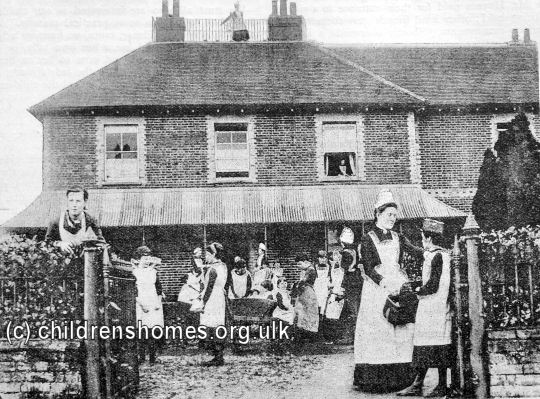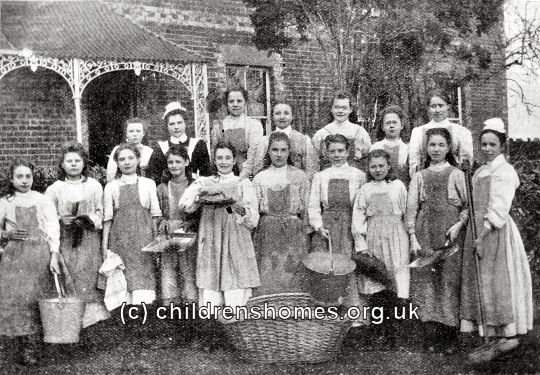Hill House / St Mary's Home, Cold Ash, near Newbury, Berkshire
The Hill House home was established in 1885 by the Waifs and Strays Society in a rented property at Cold Ash, near Newbury. The building had previously been used as a school. On November 27th of that year, it was officially certified to operated as an Industrial School, allowing it to receive children placed there by magistrates' courts for matters as vagrancy, begging, or living in the company of prostitutes. The home was originally allowed to accommodate up to 30 girls, aged 7 to 14 at the time of admission. The first inmates took up residence on March 2nd, 1886, with the formal opening of the home being performed on May 29th by John Mackarness, the Bishop of Oxford.

St Mary's Home, Cold Ash, Newbury, c.1907. © Peter Higginbotham

St Mary's Home, Cold Ash, Newbury, c.1894. © Peter Higginbotham
The home had a difficult start. An inspection in 1886 recorded 27 girls in residence, of whom 18 were under a detention order and 9 were there voluntarily. Although most of the girls had been doing fairly well, one or two older ones of bad character, transferred from another school, had been very troublesome, trying the staff to the utmost. The staff were young, insufficient, and lacking in special experience of the work. One girl had absconded and taken another with her although both had been brought back. There had been many cases of bad language and rudeness, and unruly disorder, outbreaks of temper, and falsehood. One very depraved girl had been dismissed. There was no regular teacher.

St Mary's Home, Cold Ash, Newbury, c.1890. © Peter Higginbotham
In 1890, it was noted that the making of mob-caps and jam had been adopted as special industries with considerable success. Fund-raising was also taking place to raise £1,000 to purchase the home and grounds, and a bazaar was about to held with this object. From 1893, the establishment was known as St Mary's Home for Girls.

St Mary's Home, Cold Ash, Newbury, c.1894. © Peter Higginbotham
Christmas was always a highlight of the children's year, with presents and other treats. Here is an account of a visit to St Mary's on a day just after Christmas, 1893.
The festivities began early, and soon we all assembled in the schoolroom to hear the girls sing and recite. They stood in rows in the desks, a happy little party of bright-faced children, in red or dark blue frocks and white pinafores; the elder girls at the back (the servants of the house) in caps and aprons.
The Lady Superintendent presided at the piano, and the programme was gone through with spirit.
The baby of the establishment, who had only lately arrived, sang lustily, with a pleasing disregard of words, dropping her jaw to such an extent that dislocation seemed possible.
By her side stood Chloe, a negro child found in Pembroke in a most neglected handsome and now a little girl with charming manners.
The unintentional pathos which must arise in such an assembly of children who are fatherless or motherless and worse, was suggested to the audience by the singing of one of Alfred Scott Gatty's delightful songs, with the refrain—
"Good-night, papa, good-night, mamma,
I must love Dolly best."
Then a move was made into the next room, where the Christmas-tree was lit up.
The children stood in a large ring hand in hand, too much impressed at first to speak; but as the presents were cut down they found their tongues, and soon the room was full of the chatter of happy voices.
All the presents had been given by kind friends, who would have been well repaid could they have seen the pleasure of the little ones.
Surely of all Christmas entertainments, a children's party means most to those who love all children for the sake of the Christ Child; and what children can be more dear to His heart than those who have known hunger and cold and want?
The festivities ended with a magic lantern shown by a lady who has always been a great friend to the Home.
This was thoroughly enjoyed by all except the baby, who, like other babies before her, screamed when a rat went down a sleeping man's throat, and hid her sleepy eyes on the matron's shoulder.
Cheers were given for everybody in shrill childish voices, and soon a silence fell over the house. Dolls slept peacefully by the side of their new possessors, who held them with soft dimpled fingers.
We were up early the next morning, and began the day with service in the beautiful little chapel. The demeanour of the children was most reverent, and the singing very hearty.
Then came the making of beds, in which even the baby took her part, and after that some went into the schoolroom, and others to do housework. We went into the schoolroom to see the opening, and during the hymn the baby regarded me solemnly, and at last with the gravest face in the world she distinctly winked.
Reports on the home steadily improved. A 1910 inspection found 31 girls at the home, with 11 voluntary cases. It was noted that all parts of the building were in good order and beautifully clean. The girls' singing was described as very fair, composition good; recitation, mental arithmetic, and geography were all good or fair. Senior girls received lessons in domestic economy. Needlework was said to be beautifully done, stocking darning worthy of special praise, and laundry work good. Swedish drill was being very well taught with marching smartly done. Daily walks were being taken and cricket and other games enjoyed. Discipline problems were relatively few. There had been some trouble with the insolent conduct of two or three of the older girls and one girl had been found guilty of thieving. Encouraging reports had been received of girls who had gone into service.
An additional wing was subsequently constructed, which was dedicated by the Bishop of Reading. Further new buildings at the home were dedicated by the Bishop of Oxford, now Francis Paget, on December 8th, 1907. These provided new kitchens, a playroom and a new chapel. Between April and November 1906, while the building work was taking place, the girls were housed at two 'auxiliary homes' at 'Roundhill House' on The Broadway, Kettering, and 'Sycamore' on Park Road, Moseley.

Younger girls at St Mary's Home, Cold Ash, Newbury, 1907. © Peter Higginbotham
The 'industrial training' provided at the home included cookery, laundry work and needlework, all intended to make the girls employable in later life, in most cases as domestic servants. Some of the girls' kitchen produce, such as jam, was sold at local events such as church fêtes.

Old Girls at St Mary's Home, Cold Ash, Newbury, 1907. © Peter Higginbotham

Nurse and the 'babies' at St Mary's Home, Cold Ash, Newbury, 1910. © Peter Higginbotham

Matron and girls at St Mary's Home, Cold Ash, Newbury, 1910. © Peter Higginbotham
The home ceased operating as an Industrial School in 1931, and was finally closed in 1946. The building became home to St Mary's Nursery which continued operating until 1980. The property is now in private residential use.
Records
Note: many repositories impose a closure period of up to 100 years for records identifying individuals. Before travelling a long distance, always check that the records you want to consult will be available.
- Index of the Society's first 30,000 children's case files ordered by surname.
- Index of the Society's first 30,000 children's case files ordered by date of birth.
- The Children's Society Records and Archive Centre is at Unit 25, Springfield House, 5 Tyssen Street, London E8 2LZ (email: archives@childrenssociety.org.uk). Files for children admitted to its homes after September 1926 were microfilmed in the 1980s and the originals destroyed. Some post-1926 files had already been damaged or destroyed during a flood. The Society's Post-Adoption and Care Service provides access to records, information, advice, birth record counselling, tracing and intermediary service for people who were in care or adopted through the Society.
- The Society has produced detailed catalogues of its records relating to disabled children, and of records relating to the Children's Union (a fundraising body mostly supported from the contributions of children).
Bibliography
- Bowder, Bill Children First: a photo-history of England's children in need (1980, Mowbray)
- Church of England Waifs and Strays' Society [Rudolfe, Edward de Montjoie] The First Forty Years: a chronicle of the Church of England Waifs and Strays' Society 1881-1920 (1922, Church of England Waifs and Strays' Society / S.P.C.K.)
- Higginbotham, Peter Children's Homes: A History of Institutional Care for Britain's Young (2017, Pen & Sword)
- Morris, Lester The Violets Are Mine: Tales of an Unwanted Orphan (2011, Xlibris Corporation) — memoir of a boy growing up in several of the Society's homes (Princes Risborough, Ashdon, Hunstanton, Leicester) in the 1940s and 50s.
- Rudolf, Mildred de Montjoie Everybody's Children: the story of the Church of England Children's Society 1921-1948 (1950, OUP)
- Stroud, John Thirteen Penny Stamps: the story of the Church of England Children's Society (Waifs and Strays) from 1881 to the 1970s (1971, Hodder and Stoughton)
Links
- Hidden Lives Revealed — the story of the children who were in the care of The Children's Society in late Victorian and early 20th Century Britain.
- The Children's Society
Except where indicated, this page () © Peter Higginbotham. Contents may not be reproduced without permission.


